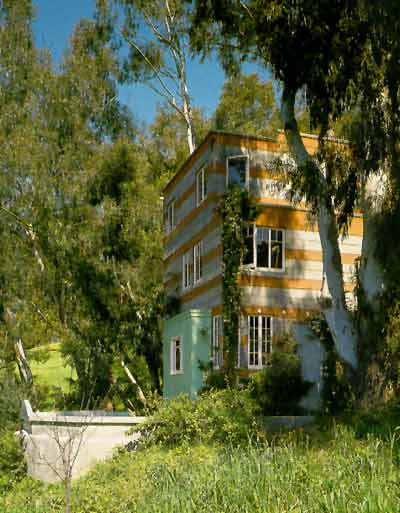| Sorted by date | |||
page203from Building Ideas
7 Christopher Alexander et al. – Mexicali
Housing, Mexico, 1976. (Neil Jackson)
Aside
from the questionably “spiritual” qualities that might be present in Alexander’s
architecture, in the context of modern Japan this project was seen as a threat
to the economic system. In Alexander’s words this confrontation takes on the
scale of a heroic encounter, but it does show the consequences of any attempt
to subvert the system:
We
see the Japanese (construction) companies aware, for the first time, of the
fact that our intention to implement system A, might have serious consequences
for their own future in Japan. What we were doing, … in its pure form posed a
threat to the whole Japanese construction industry. … They therefore set out to
ensure that it must fail.37
|
|||
|
|||
|
|
|||
page202from Building Ideas
5 Christopher Alexander et al. – Sala
House, Albany, California, 1982-85: Interior.(Neil Jackson)
6 Christopher Alexander et al. – Sala
House, Albany, California, 1982-85: Interior.(Neil Jackson)
discussing the Eishin campus, constructed
in 1985, Alexander presents the project as a kind of civil war between two
competing systems of buildings. The first – “world system A” – is based on his
use of the Pattern Language, and the second – “world system B” – the
conventional, professionally organized, construction process.
World
system A is based on human feelings. It is engaged in trying to create a world
in which human feeling comes first, … and in which wholeness (and) rightness, …
is the quality in the world, which embodies and depends on human feeling at
every point. World system B is based on mechanical and unfeeling processes. It
poses a world of money, opportunity and power, in which ultimate things –
wholeness and spirit – are relegated to a very distant palce.36
|
|||
|
|||
|
|
|||
page201from Building Ideas
4 Christopher Alexander et al. – Sala
House, Albany, California, 1982-85. (Neil Jackson)
this can be seen in the involvement of
users in design, and there are several cases worth considering, particularly
for their curiously similar formal characteristics. These range from whole
cities constructed by their inhabitants, such as Paolo Soler’s monumental
Arcoscanti, down to the one-off house built by the client, with the architect
acting as an onsite advisor. This latter scenario has been championed by
Christopher Alexander, who started life as a mathematician, and then went on to
analyse the process of design through a system of numerical variables. In his
later work this approach softened somewhat into the more flexible method of
designing with Patterns, which he then developed into a handbook or manual,
which could be used by anyone to design a building to their own requirements. At
the Sala House in California this was applied to a single family dwelling, but
he has also worked on larger scale developments, such as a college campus in
Japan. In
|
|||
|
|||
|
|
|||
page200from Building Ideas
3 Paolo Soleri –“Arcosanti”, Arizona, 1969
onwards.(Neil Jackson)
would
be the equivalent of the rules of metre and rhyme for poets of earlier times: a
body of constraints stimulating new discoveries, a set of rules with which
improvisation plays.35
This
notion of improvisation recalls the architectural intentions of Herman
Hertzberger, who also attempted to inspire this kind of engagement between
buildings and their users. A more extreme example of
|
|||
|
|||
|
|
|||
page199from Building Ideas
level of every day “tactics”. This
difference was theorized more specifically in the work of Michel de Certeau,
who was also influenced by Lefebvre’s writing on everyday life, in the
development of his notion (with reference also to Foucault) of an “anti-disciplinary”
practice of resistance to authority:
Many
everyday practices (talking, reading, moving about, shopping, cooking, etc.)
are tactical in character. And so are, more generally, many ‘ways of operating’;
victories of the ‘weak’ over the ‘strong’(whether the strength be that of
powerful people or the violence of things or of an imposed order, etc.), clever
tricks, knowing how to get away with things, ‘hunter’s cunning,’ … The Greeks
called these ‘ways of operating’ metis. But they go much further back to the
immemorial intelligence displayed in the tricks and imitations of plants and
fishes. From the depths of the oceans to the streets of modern megalopolises,
there is a continuity and permanence in these tactics.34
This
idea of appropriation is described by de Certeau as a mode of resistance to the
dominant practices of capitalism in modern society. This also parallels an idea
of Barthes on the subversion of dominant discourses, and the ways in which the
active reader reappropriates a text – as de Certeau would have it, reading as “poaching”
– or meandering through a text like Benjamin’s wandering flâneur. This technique
of creative reading, which becomes almost an act of rewriting, is likened by de
Certeau to the inhabition of space, and he also connects this idea with
improvisation in poetry:
This
mutation makes the text habitable, like a rented apartment. It transforms
another person’s property into a space borrowed for the moment by a transient. Renters
make comparable changes in an apartment they furnish with their acts and
memories; … as do pedestrians, in the street they fill with their desires and
goals. … The ruling order serves as a support for innumerable productive
activities, while at the same time blinding its proprietors to this creativity …
Carried to its limit this order
|
|||
|
|||
|
|
 ... ...
... ... ... ...
... ... ... ...
... ... ... ...
... ... ... ...
... ... ... ...
... ... ... ...
... ... ... ...
... ... ... ...
... ... ... ...
... ... ... ...
... ... ... ...
... ... ... ...
... ... ... ...
... ... ... ...
... ...


